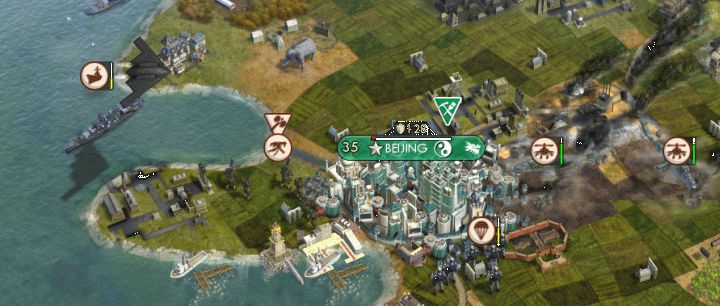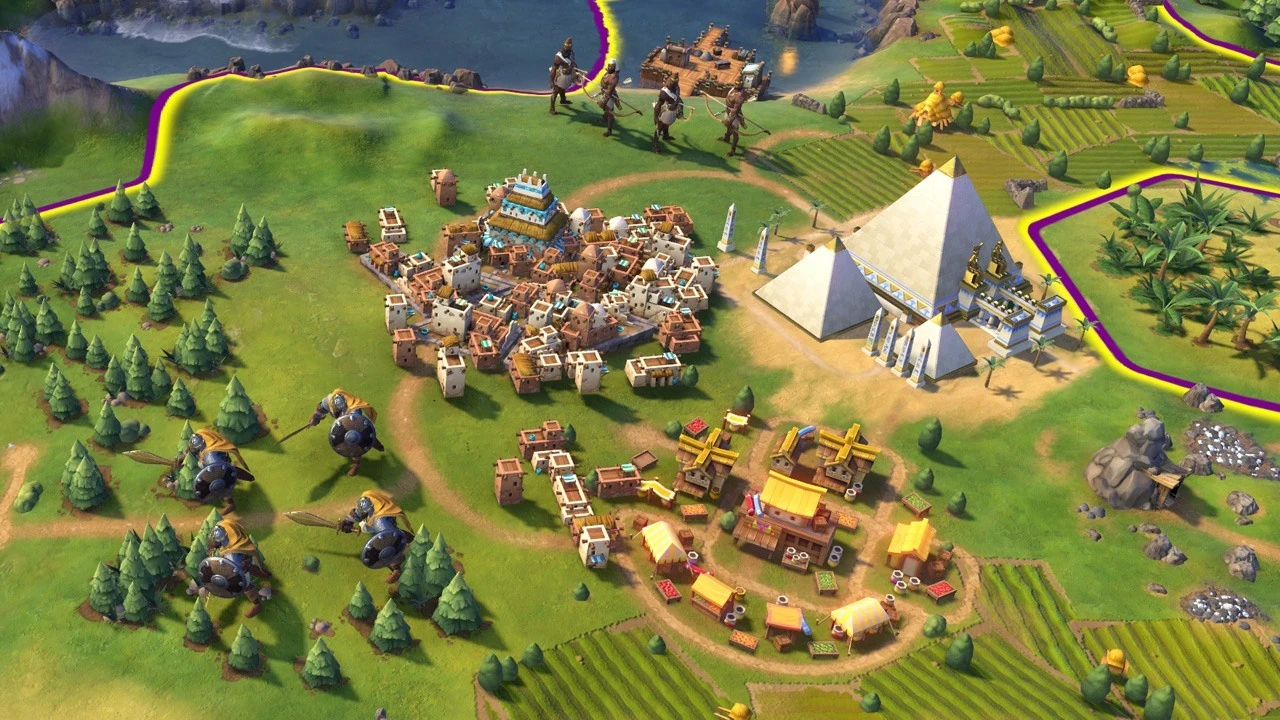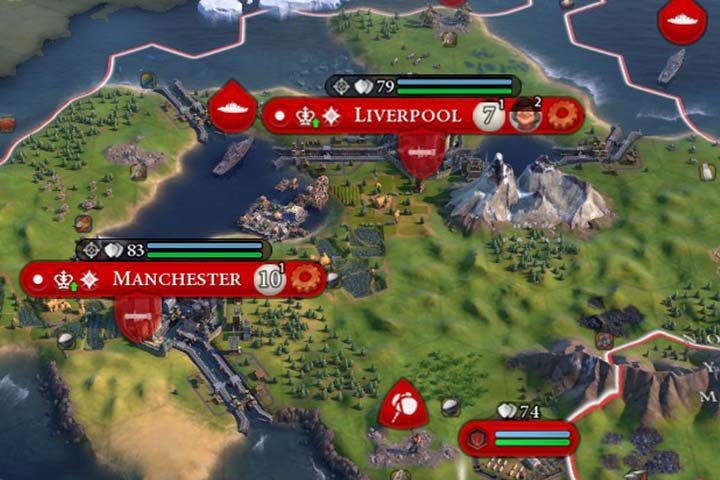Remember, Civ 6 doesn’t support 32-bit operating systems. Second, ensure Civ 6 has been correctly installed on your machine. Right-click the game in your Steam library and select ‘Properties’. Start by adding an exclusion for your Civ 6 folder. In Windows 10, from the start menu, go to ‘Settings’, then ‘Update & Security’, then ‘Windows Defender’. Click ‘Add an Exclusion’, and then. Other things you can try to fix CIV 6 crashes and related problems on Windows 10 If you still have not found a way to get the Civilization 6 application to stop crashing on your Windows device or if you are yet to fix a related problem that brought you here, then you might want to go through this additional list of procedures, recommendations. Districts are now placeable through the Plot Editor Districts can now be pillaged by the Placement Tool or Plot Editor. Delete units when a player is edited. Fix case where capital city would have no name if you changed a civ's leader to not match (Should help with mod civs too). Fixed issues with the Plot Editor Improvement Pillaged checkbox.
One of my favorite games is Path of Exile, an action RPG which I find delightfully fun and creative. It’s not the fast and relatively straightforward drop-in action RPG like Diablo 3, it seems a little odd, and has complicated systems. These complications though, lead to creative, fun, and flexible gameplay. It’s more like a deck building game.
I realized that there is a distinction between ‘quick fun’ games, where you want to just sink in for a while and have a good time doing what you already know how to do relatively well, and ‘learning games’ where you have to continue to invest time in learning new complicated mechanics, and eventually achieve a sense of mastery. In these games experts sometimes proclaim the game ‘easy’ because they understand its systems well, but ‘easy’ often costs them hundreds or thousands of hours.
Civ 6 Pillaged Farm
I feel like the Civilization series is very much the learning type of game. I played the earlier Civ games a bit, back to Civ 1 briefly, a bit of Civ 3, and around 12 hours of Civ 5 according to steam. I did ok on low difficulty settings, but I didn’t get to “mastery” really. I think the series is worthy of some learning investment, so I’m going to explicitly treat Civ 6 as a learning experience.
So… Playing to learn means that winning is a secondary goal. No restarting when things go badly, I’ll carry through the bad time and try to learn lessons from them (not that I won’t end it when it’s past the point of usefulness. I want to note a few thing that I’ve learned as I go explicitly to help crystalize the knowledge. When I notice problems that might have been remedied with better planning many turns ago, I want to capture that for more thought later. When I have mechanics questions I’d like to raise them, answer them, and maybe do some science or research around them.
Here are some thing I’ve learned in my first default settings game so far:

- Barbarians are a threat early on, and need countered. I recall that they don’t appear where you have vision, so at least nearby scouts are good.
- Settling early can be high value. Picking places is important, and I’m not convinced the recommendations are very good long term. Freshwater from a river, or a one tile connection from a mountain are ideal. Due to 4 extra housing (+6 vs +2) from Aqueduct, is it actually better long term to NOT have fresh water if you planned a one tile gap from a mountain? Or skip Aqueduct? I recall something about Nighborhoods later, so maybe only medium term.
- Escorts are a nice touch. Non military are captured when touched, captured barbarian builders this way. Wat? I recall hearing that settlers can be captured this way…
- Unhappy cities (amenities too low) can revolt, which costs population and generates barbarians. These can be your good units, in my case 2x Conquistadors, my best unit. Not too terrible to clean up with city bombard, but definitely annoying.
- Amenities are somewhat confusing, sources, flow between cities.
- You can ‘race’ a nearby border to claim valuable land by spending gold.
- Gold flows more freely in this version, and fills a lot of gaps.
- Ranged units are powerful, not just for the literal range, but also because they don’t take losses when attacking, even other ranged units. Only while defending.
- The rock-paper-scissors of early units matters, too many chariots and unable to take on spears.
- Unit upgrades only occur on home territory tiles, and can be high value. Slings to archers was helpful. Can pre-plan these, build up an army and save gold, get the tech, and upgrade for an offensive.
- Special resource requirements are problematic, no horses, although I can build chariots. Is that a bug? I got access to swordsmen, but I can’t make any due to lack of iron. Seems to affect game flow.
- My science instinct is strong, but I need to not sacrifice short term health too much.
- Terrain affects combat, rivers boundaries are easy to defend (+5 to defender), hills did something I think.
- Wonders are a race, and you lose the production for no gain if someone beats you there.
- I’m not good at diplomacy yet, it looks challenging. I probably need to manage it well enough not to get double attacked, but for now I’ll plan on getting attacked (DoW = Declaration of War) and let it happen.
- Too little army going into a war, painful to catch up.
- Builders can repair pillaged improvements (e.g. the things they can build) in one turn for no cost. Buildings from the capital need repaired by production.
- Production is like stored time, and efficiency here is super helpful.
- In general, it appears that most science (and civics) have boosts. Ignoring it for now, but later it feels like planning boosts properly could be a significant acceleration.
- War is super distracting from progress, can derail wonders, infrastructure.
- War costs amenities through war weariness.
- How city sieges work is confusing. This helped: http://www.idigitaltimes.com/civ-6-guide-how-siege-cities-and-conquer-your-enemies-564550
- Siege notes: Walls take only 15% dmg by default, protect city, half that from ranged. Siege units explicitly attack walls at full rate, or bypass walls and attack city at full rate. Healing can be stopped by ‘controlling’ all tiles (occupy, or ‘zone of control’ with ranged)
- Capturing vs Razing is an odd choice. If the city is near me and badly placed, is it better to keep, or remove. I recall someone mentioning reconciling cities at the end of a war. I had to turn down peace when winning. because they refused to give my big city back.
- What the heck is Niter?
- Religion is complicated, and I’m unsure of the impact. I’m ignoring it for now, even as Japan rolls through my cities. Lost my initial religion. Not great compared with being spain and having religious oriented bonuses.
This was a big ‘after the fact’ dump a while into my first game. I’d like to leave the blog post open and edit it as I go in future.
The Builder is available at the very start of the game and it begins with actions at the start of the game called charges. These actions, or charges, are things like making tile improvements or clearing out resources. You can tell how many charges a Builder has by its icon or at its information menu. If the Builder icon has two Builders that means it has two charges left. A new Builder, unless the base number is increased through governors and policy cards, starts out with 3 charges.
You use Builders by moving them to the tile you want worked. On the next turn you chose the action from their information bar and the action is completed instantly, regardless of whether you’re harvesting a resource or constructing an improvement like a mine. Builders start with three available charges, and each harvest operation or tile improvement uses up one charge. Builders can also be used to get technology and civics boosts by performing the required actions for those items. When all the Builder’s charges are used it disappears from the game.
The most fundamental use of a Builder is to clear resources and to build tile improvements. In the early game the ability to clear resources is vital. Although it uses up a Builder charge it provides you with some added resources, like production and food if harvesting a Rainforest. If you simply improve the Rainforest tile by constructing a Lumbermill without first clearing the tile you’ll lose those resources. Whether this is worth using up one Builder charge depends on how badly you need the resources.
The other essential Builder ability is the ability to improve tiles, like building Lumbermills or Farms for example. Like all Civ 6 units, Builders have a limited number of hexes they can move each turn, at the start of the game the Builder is limited to 2 tiles of movement per turn. Builders also can only build within the borders of a city although they can travel from city to city to build improvements.
Creating improvements is simple. First move your Builder to the tile you want to improve. Once the Builder has arrived at the tile check the set of icons at the bottom left part of the screen in the information bar. There will be 2 or 3 rows of them and most of them will probably be grayed out, only actions the Builder is able to perform will be active. At the top center of these icons there will be an action your Advisor recommends, like building a lumbermill. Click on it and your Builder will instantly build the improvement, it won’t be built over a number of turns like buildings are. You don’t need to listen to your advisor and can chose to do something else that is active instead, like clearing out the area first to gain the resources from the tile.
Builders also repair pillaged improvements but can’t repair damaged buildings, that needs to be done using the city’s menu production screen. Once the Builder arrives at a pillaged tile a repair icon will be available for use and taking this action will not use up any charges from the Builder. Another thing that does not use up a Builder charge is removing tile improvements.
Need some help deciding where to build cities or how many cities to build? Read my article about choosing where to settle and my page about how many cities to build.
How To Fix Pillaged Land Civ 6 Free
Like most things in Civilization VI, your early strategy depends on your surroundings and any threats that are close by. If there are no threats nearby, like Barbarians, and you have some great tiles around your city that can be upgraded or harvested, then creating a Builder after a Scout is an option worth pursuing. Otherwise, it’s best to wait several turns before creating a Builder. Normally it’s better to build a Scout first, then a Slinger to defend your city from any hostiles like Barbarians. Depending on the situation you might build either another military unit of some type to help take care of a Barbarian camp or another Settler to found another city, or both, so a Builder can be as late as the fifth item you choose to create.
The first builder you create should be used to improve available resources and then to build farms if you can’t improve anything else. The Builder should also be focused on achieving technology boosts along with tile improvements, like improving any 3 tiles to boost the Craftsmanship civic. Civics boosts can be coupled with technology boosts as well. For instance, farming a tile will give irrigation technology a boost and still contribute to the Craftsmanship Civic boost as well.
After the first builder the next steps can be in one of two directions. You can create a Builder for each new city you establish and have him do the same basic things as the first Builder.
The second option is to wait until the Serfdom policy card becomes available, which is unlocked by the Feudalism Civic in the Medieval Era. Hold off making any new Builders until this becomes available and then build as many as you need, or until the time comes to change policies again. Any newly created Builders get two extra charges because of the Serfdom policy card, meaning you can get a lot more uses out of them, almost twice as much.


If you want to get even more uses out of your Builders establish Liang, The Surveyor, as a governor of one of your cities. With her Guildmaster ability any Builders created in her city get an additional charge. That, coupled with the Serfdom policy card, will give Builders created in her city 6 charges instead of 3.

Another method to gain extra Builder charges is to build the Pyramid wonder. Once finished it gives all your Builders another charge, even Builders who have already been created.
If you have Rise and Fall establish Magnus as the Governor for one of your cities since he grants additional income from cleared resources, just be sure to place him in the city having the tiles your Builder is improving. Early in the game this extra production is great for using it on other needed things. Once a Builder has finished work in one city move Magnus to the next city having tiles that can be improved.
Although obvious it’s worth mentioning that high yield tiles and mines should be improved first by Builders. Farms are almost always your lowest priority. In order to maximize their adjacency bonuses the optimal layout is to build Farms together like a pyramid.

How To Fix Pillaged Land Civ 66
If you want to read up on how to spread religion go to this page on my website.
If your Builders won’t build anything the first thing to check is to see if they’re on a tile that can be improved. If a Builder is on a workable tile make sure you have the right technology and/or civic researched. Also make sure the Builder is within a city’s cultural borders. At the beginning this will be a 7 tile circle around the city. If the Builder is outside the city borders then he won’t be able to build anything.
Civ 6 How To Fix Pillaged Tile
There are also certain circumstances when your Builders can’t build what you want them to build. You will be unable to build a farm if there isn’t any water close by or a mine if you don’t have Mining researched. Special ecological conditions, like a drought, can prevent you from building certain tile improvements, like Farms, as well.
When a Builder disappears it’s because of the design of the game and not a bug. Once all a Builder’s charges are used up, which is typically 3, the unit disappears from the game.
How To Fix Pillaged Land Civ 6
Need better hardware? Does you PC panic when you fire up that new game? See my
recommended PCs, Laptops, Mice, Keyboards, Speakers and Monitors at these pages on my website.